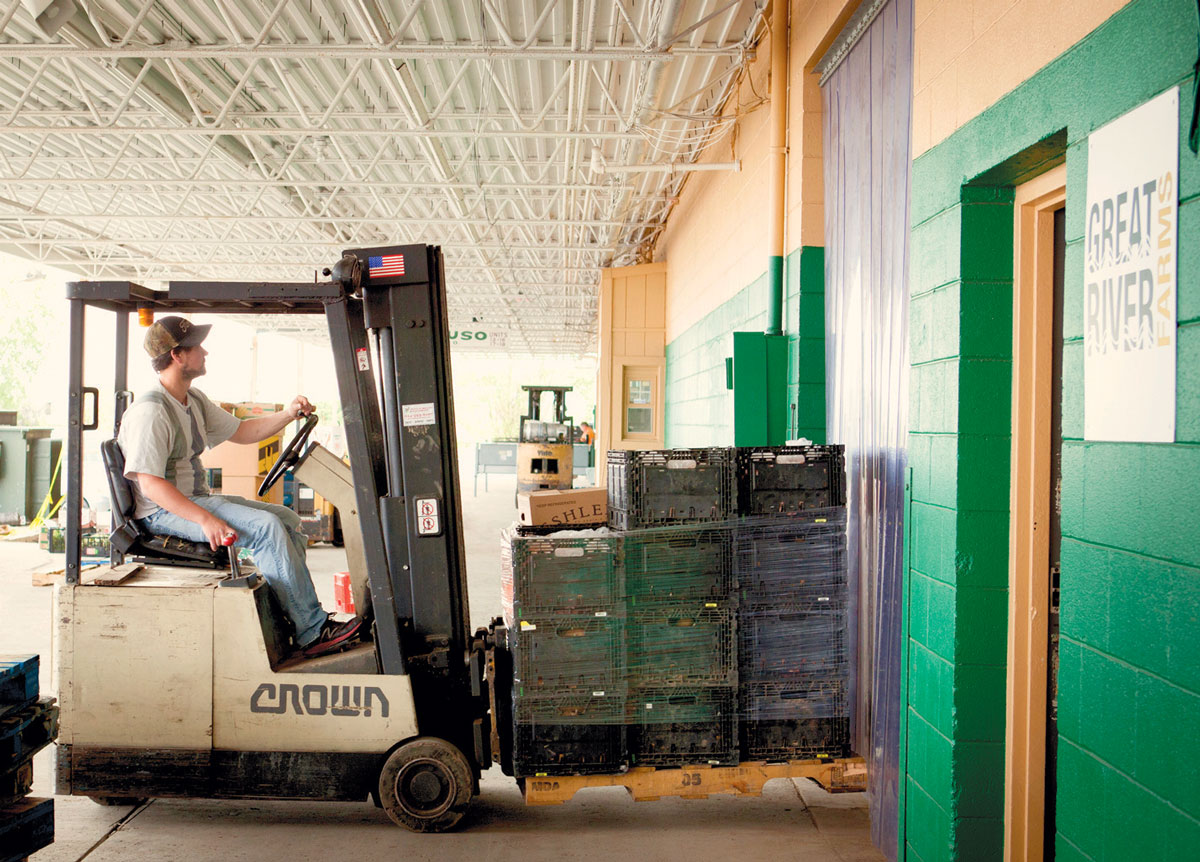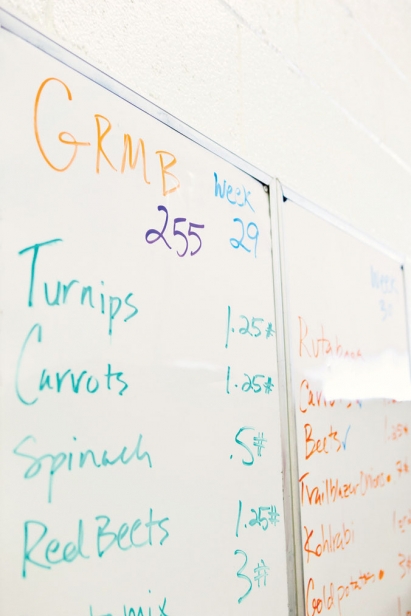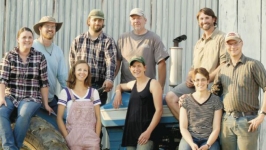One Brick at a Time
Building a local, organic supply chain with Great River Organics
The story of our cooperative, Great River Organics (GRO), is one of great compromise, frustration, and, ultimately, success. I am truly proud that we never gave up. We had tried to create a growers group in a myriad of ways over several years. We kept talking, we kept thinking ahead, and we finally found a way.
After a seven-year effort to create a platform for farmer-owned distribution, we started with the name Great River Farms in late 2013. We had two of our farmers who were in their last year of transition to be available for certified organic status. We couldn’t yet market all of our produce as organic and we patiently waited for all of our farmers to unify standards of marketing and production. In our first year of business, we fostered a new multi-farm CSA (Community Supported Agriculture) and wholesale program. With the start of our second year, we have officially transitioned ourselves to Great River Organics, a farmer-owned, certified organic cooperative.
Over the past five years, we have seen the marketplace dramatically evolve. Many of the member farmers of GRO started their farms around the farmers markets, small restaurant relationships, and CSAs. CSAs were really the growth model for small, organic farms looking to find a more stable marketplace to sell their products and utilize the upfront dollars to invest in on-farm efficiencies.
All markets change, however, and the CSA market has taken a sharp downturn in the past several years. Increasing competition among farmers, a thriving natural grocery store industry, and, lastly, the advent of third-party food delivery services falsely marketed as CSAs have all contributed to change the landscape. Fifteen years ago, the farmers market or a CSA was your go-to for organic foods. In today’s market, every restaurant seeks farm-to-table credibility; local means moral, and everything—I mean everything—is sustainably grown.
In anticipation of these coming changes in the marketplace, Wayward Seed Farm partnered with Local Matters, the United States Department of Agriculture (USDA), and other farmers in 2010 on a two-year feasibility study to research the development of an all-organic farmer-owned cooperative in Central Ohio. Our findings were mixed. Farmers certainly wanted to sell more products and create a better interaction with the wholesale business arena. We found, however, funding and capacity barriers too great at that time to develop a business plan.
It took almost two more years to organize ourselves into Great River Organics, an organization that strives to build prosperity through product standards, research, sales, and logistical services. GRO gives our farmer-owners an opportunity to grow more food and perhaps recruit new farms that align under the banner of a new, Ohio organic brand. More than anything GRO creates a new professional organization for us to interact with the community.
During the early phase of our feasibility study, Adam Utley, my good friend and colleague, and I wrote down a roadmap to improve local food supply chains. I’m glad we did. The tenets of GRO were founded in this original roadmap, which described how we could build new institutions of local food, centered on transparency and an honest effort to leave our farms in a more pristine state than when we started.
Here is what Adam and I call “The Six Values:”
1. Commitment to Farmer-Owned Distribution
Great River Organics is farmer-owned and operated. Our farmer members own the value chain from seed to delivery; 100% of profits stay with the farms. We operate the farms, we pursue sales relationships, we coordinate production among the farms, and, finally, we operate a warehouse to conduct distribution. To gain prosperity on a small to medium scale, farmers need to own as much of the value chain as possible. We can cut our costs as producers by cooperatively purchasing packaging, fertilizer, potting soil, and even equipment. By unifying our production standards and working together, we produce larger lots of food that can better serve our markets. It’s simple. When farmers organize and work together, everyone can benefit more equitably.
2. Certified Organic Farming Practice
Our farmers have chosen to pursue certified organic practice as our baseline farming method. We believe that this is essential to provide transparency to the consumer day in and day out. We want to foster a new future for ecological farming where practices continually improve. By agreeing to set standards as a co-op we can move ahead together as better stewards of our land and an example to new and emerging farmers. If GRO can build more successful, organic farm businesses, then young people can observe this type of farming as a viable economic opportunity that also has environmental, social, and economic benefits for the community. As I tell my young farm workers, “We have to transition organic farming from a summer rite of passage for new college graduates to a viable career option.” Yes, certified organic brings a premium for our farmer owners. It should—great food quality is what we seek to produce; food grown through deft agricultural practice.
3. “Seat at the Table”: Inclusion of farm producers as stakeholders in policy decisions
It is absolutely important for farmers to demand their presence at policy meetings. As much as it is important for our representatives and policy makers to determine our needs through surveys and marketing trends, farmers are many times absent in the policy discussions that decide grant streams and community funding. Producer pools must aggressively reach out and make their needs known. Farmers can’t just use their demanding schedules on the farm as an excuse for not engaging with our policy officials. They work on our behalf every day. We can’t complain about food safety regulations, or other topics when we aren’t at the table to discuss these potential changes to our farms. It is our responsibility as producers to take our seat and speak out on policy.
4. Traditional Lending and Community Investment in the New Farm Movement
Just like growing consumer choices, organic producers need more investment options today. We are repeatedly told that our type of farming is too risky, or that the yields are too low. This is a ridiculous argument to make in 2015. Ohio regional, organic farmers are under-serving their high-demand marketplace. We need to build capacity today through on-farm investments in land, equipment, and infrastructure. How can we finance expansion when lenders won’t assume more of the risk with us as producers? It is time for consumers to realize that voting with their fork has limited impact to help scale new farm value chains. We need local and regional lenders to act as a conduit for community investments in Ohio farms. If farms have lending needs, their journey for investment must be more simplistic and fair. (See page 54 for the article “Locally Grown Investment” about investment strategies for local, organic farms.)
5. Gaining the Commitment of Institutions as a Sustainable Customer
In the past few years, there’s been movement toward including large buyers such as schools, hospitals, and universities as capacity-builders for a new farm economy. A very large buyer could utilize massive allotments of produce in a given season, which translates to a huge growth and stability opportunity for farmers. This has been a difficult nut to crack, however, because institutions almost universally assume that certified organic food is too expensive for their budgets. But when we meet with institutions, they are surprised to learn that simply isn’t the case. Certified organic shouldn’t be a scarlet letter; it should encourage a buyer to feel confident about our farmers’ transparency. GRO believes institutions can be leaders in finding common ground with farmer-owned production groups to secure measurable levels of their supply chain both regionally and organically.
6. Bridging the Gap Between the Urban and Rural Culture Through Community Engagement
It is imperative that an urban movement of consumers and producers interface more regularly with their rural stakeholders. Too often the food movement strikes up contentious feelings regarding grant streams, production feasibility, animal husbandry, and labor practices, just to name a few. The distance between urban viewpoints and rural ones is a centuries-old quandary that seems at times too difficult to tackle. GRO and other farmer-owned businesses need to have more discussion and interaction with their urban supporters on a frequent face-to-face basis to understand our differences and cohesion. Whether it is a large on-farm event once or twice a season, or a local discussion group that meets monthly, we need to shape an “Ohio” vision for organic and new farm agriculture that has a realistic scope. We will need to bring our rural and urban communities together because remaking our agriculture system is a “Purple State” reality.
Great River Organics and its farmers have a bright future. Our success will be paved through continual reciprocity on the farm and in the marketplace. I think it’s the responsibility of our generation—the new and emerging organic producers of this era—to build upon the work that our mentors so tirelessly legitimized. As a community, we’ve gone from fringe to mainstream conscience over the past 30 years. My hope is that it’s only just beginning.
Learn more about Great River Organics at greatriverfarms.org.







